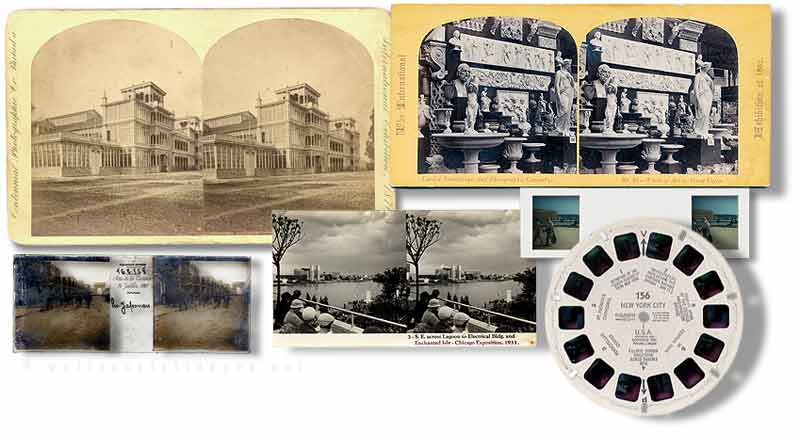After the invention of photography (1839: Niépce / Daguerre) stereoscopic photographs were soon realised with the several processes.
The first stereoscopic photographs were uniques corresponding to the developed processes: daguerrotypies, talbotypies. After the invention of the wet-plate and the dry-plate proocesses in the fifties of the 19th century it mostly had been paper prints pulled up on pasteboard until the twenties of the 20th century.
Here you can see some sizes of stereoscopic views.
Paper prints pulled up on pasteboard [above left and right] were the wide-spread format.
Next there were glas-stereos, printed stereocards and since about 1939 the viewmaster size. Then there were special sizes, based on the standard small filmsize, like the size of the Koak Stereo Camera of 1954.
Soon every size needs another kind of viewer.
[above left] : Machinery Hall from Finance Building, International Exhibition 1876; Centennial Photographic Company Philadelphia, 1876; pasteboard size 8,3 cm x 17,2 cm, picture size 8,7 cm x 14,5 cm
[above right] : Works of art in terracotta, The International Exhibtion of 1862; London Stereoscpoic and Photographic Company, 1862; pasteboard size 8,3 cm x 17,2 cm , picture size 7,8 cm x 15,1 cm ,
[below left] : Versailles - Signature de la Paix 28 Juin 1919 ; stereo glass positive, Verascope Richard, size 4,5 cm x 10,7 cm, ingle picture size: 4,0 cm x 4,0 cm
[below central] : S.E. across Lagoon to Electrical Bldg. And Enchanted Isle – Chicago Expostion 1933; picture size 5,5 cm x 11,9 cm
[central right] : Kodak Stereo Camera size, 1954, size 3,0 cm x 10,0 cm, single picture size: 2,2 cm x 2,5 cm
[below right] : No. 156 New York City; Viewmaster reel, 1952, 7 stereoviews, diameter 9,0 cm, single picture size: 1,0 cm x 1,2 cm


